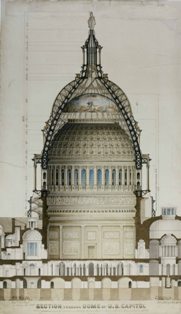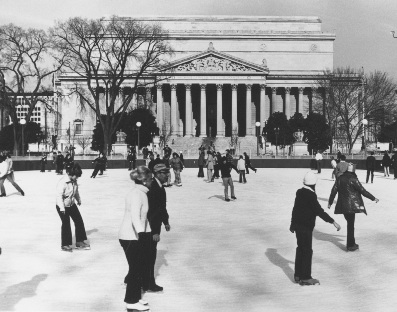- About Archives
- About SAA
- Careers
- Education
- Publications
- Advocacy
- Membership
 Exploring America’s Capital City
Exploring America’s Capital CityWashington, D.C., is like a second home to many archivists, who are familiar from childhood (or 8th grade field trips!) with the museums and monuments that decorate our Capital City. We encourage you to visit those favorite places again before, during, and after DC 2010. But we hope you’ll also take the opportunity to explore our neighborhoods and check out what’s new in town. Our city streets have something for everyone!
Situated on 16 garden acres in Woodley Park, the Washington Marriott Wardman Park (our DC 2010 headquarters) is the capital’s largest hotel. It’s nestled in a lively residential area whose tree-lined streets are flanked by friendly boutiques, coffee shops, and sidewalk cafes featuring cuisines from around the world. To the east sits Rock Creek Park, a vast urban green space (larger than New York City’s Central Park!) that sports walking, running, and bicycling trails and that is home to the Smithsonian’s National Zoo.
Explore the neighborhood: Get to know the stone gargoyles (including one shaped like Darth Vader) carved into the façade of the stunning Washington National Cathedral. Marvel at Marjorie Merriwether Post’s impressive collection of Russian imperial art at Hillwood Museum and Gardens. Take the kids to meet giant pandas Tian Tian (t-YEN t-YEN) and Mei Xiang (may-SHONG) at the Zoo. And feast on renowned Mediterranean fare at Lebanese Taverna – a short walk from the hotel. At the foot of the hill on which the Marriott Wardman Park sits is the Woodley Park/Zoo Metro station (Red Line) – your connection to all that our Capital City has to offer. (Where: Connecticut Avenue north of Dupont Circle, east of Rock Creek Park)
Across the Taft Bridge to the south, Dupont Circle/Kalorama is an urban neighborhood that features cafés and restaurants, boutiques, and a significant arts and culture scene, including the Phillips Collection (America’s first modern art museum), the Textile Museum, and the National Geographic Museum. The largest concentration of international embassies sits just northwest of the Circle, giving the neighborhood an extra dash of global flavor. Try the popcorn shrimp and fried clams at Hank’s Oyster Bar or choose from “the world’s largest selection of beers” at The Brickskeller. (Where: Connecticut, Massachusetts, and New Hampshire Avenues, at P and 19th Streets)
Heading farther south: Long home to immigrant communities from Africa, Asia, and South and Central America, Adams Morgan is a global village in the heart of the city where restaurants serve cuisines from around the world and residents go to let their hair down. You can catch live music most nights of the week throughout the neighborhood and find cheap eats and white tablecloth restaurants to suit your mood and budget. Many locally owned shopping gems feature unique clothing, jewelry, art, furniture, and household goods. (Where: 18th Street NW between Florida Avenue and Columbia Road; and Columbia Road between 16th Street and Wyoming)
Other neighborhoods of interest: Anacostia (D.C.’s first planned suburb and home of Frederick Douglass’s beautiful Cedar Hill estate and the Smithsonian’s Anacostia Community Museum); Brookland/Northeast (home to more than 60 Catholic institutions and the U.S. National Arboretum); Capitol Hill/Capitol Riverfront (Victorian rowhouses and tree-lined streets are joined by the Library of Congress, the Folger Shakespeare Library, the Supreme Court building, the National Postal Museum, and Union Station); Foggy Bottom (of Watergate fame); Georgetown (for Dumbarton Oaks, Oak Hill Cemetery, the Kreeger Museum, and a seemingly endless supply of boutiques and coffeehouses); and U Street/ Shaw (birthplace of Duke Ellington and site of D.C.’s “Black Broadway” and the African American Civil War Memorial).
And if you’re up for an adventure: Take a peek at the landmarks and locations featured in best-selling author Dan Brown’s thriller The Lost Symbol. Perhaps you could track down the secret side of the nation’s capital through the book’s symbology and iconology….
 What’s New in Town?
What’s New in Town?Since our last Joint Annual Meeting in Washington (in 2006), the National Museum of American History has undergone extensive renovation, with major architectural enhancements to the interior, update of the building’s infrastructure, and construction of a state-of-the-art gallery for the Star Spangled Banner. Be sure to make some time to see Michelle Obama’s inaugural gown, Julia Child’s kitchen, “Abraham Lincoln: An Extraordinary Life,” and “Price of Freedom: Americans at War,” which explores the ways in which wars have been defining episodes in American history. (Where: On the National Mall, 14th Street and Constitution Avenue NW)
Completed in 2008, the long-awaited Newseum offers visitors an experience that blends five centuries of news history with up-to-the-second technology and hands-on exhibits. The Newseum’s collections include more than 35,000 historic newspaper front pages dating back nearly 500 years, 3,800 images on display in the galleries and walkways, 1,063 press passes, the Berlin Wall Gallery (the largest display of sections of the Berlin Wall outside of Germany), and the Today’s Front Pages Gallery (with daily front pages from more than 80 international newspapers). Two dozen interactive programs are available on 130 interactive stations. The exterior’s unique architectural features include a 74-foot-high marble engraving of the First Amendment and an immense front wall of glass. (Where: Pennsylvania Avenue and 6th Street, NW)
The National Archives invites DC 2010 attendees to a private reception on Wednesday, August 11, that will give us special access to the Rotunda and Charters of Freedom and the Public Vaults exhibits. The National Archives’ new traveling exhibit, “Discovering the Civil War” – which features the most extensive display ever assembled from the National Archives’ incomparable Civil War holdings as well as exciting interactive experiences – will also be open for tour. And there will be hands-on demonstrations of new classroom tools for primary sources in the Learning Center. We hope you can join us for this complimentary reception – and make additional time to visit the Archives during the conference week. (Where: Constitution Avenue between 7th and 9th Streets NW; researcher entrance: 700 Pennsylvania Avenue NW)
Whether DC 2010 is your first or fiftieth trip to our Capital City, we hope you’ll take advantage of the chance to be an urban explorer. From neighborhoods to iconic monuments – with lots of Starbucks and one-of-a-kind cafés along the way – walk the streets and find out why unearthing a bit of history during each visit is inevitable!
– DC 2010 Host Committee
Photo captions: Section Through Dome of U.S. Capitol by Thomas U. Walter. (Architect of The Capitol) and Constitution Avenue Side of the National Archives and Records Service (NARS) Building with skating rink.